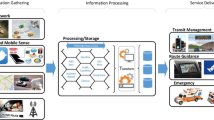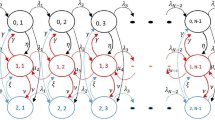Abstract
Increased vehicle traffic rate leads to higher waiting time, which would cause increased fuel consumption. Existing work 3-phase fuzzy-decision tree model attempts to make decision regarding traffic management quickly. Delay in data communication would increase the decision-making time, which is not concentrated in the existing work. In this work, Fuel Consumption and Delay aware Traffic Scheduling Method is introduced. Here when the vehicle is encountered with another vehicle, then it will communicate with the road side units and gain information such as vehicles count and coverage region. In this work coverage aware clustering protocol is introduced which would ensure the successful data transmission. Based on nodes count present within the cluster message replication quota is decided which reduce the network load. In MATLAB environment, evaluation of this research work is done and better results are exhibited by proposed work when compared with existing work as shown by results of experimentation.





Similar content being viewed by others
References
Akabane, A. T., Gomes, R. L., Pazzi, R. W., Madeira, E. R., & Villas, L. A. (2017). Apolo: A mobility pattern analysis approach to improve urban mobility. In GLOBECOM 2017-2017 IEEE global communications conference (pp. 1–6). IEEE.
Condurat, M., Nicuţă, A. M., & Andrei, R. (2017). Environmental impact of road transport traffic. A case study for county of Iaşi road network. Procedia Engineering, 181, 123–130.
Omar, H. A., Lu, N., & Zhuang, W. (2016). Wireless access technologies for vehicular network safety applications. IEEE Network, 30(4), 22–26.
Mourad, A., Muhammad, S., Al Kalaa, M. O., Refai, H. H., &Hoeher, P. A. (2017). Vehicular communications.
Jiang, J., & Han, G. (2018). Routing protocols for unmanned aerial vehicles. IEEE Communications Magazine, 56(1), 58–63.
Wahid, I., Ikram, A. A., Ahmad, M., Ali, S., & Ali, A. (2018). State of the art routing protocols in VANETs: A review. Procedia computer science, 130, 689–694.
Khaliq, K. A., Qayyum, A., &Pannek, J. (2017). Novel routing framework for VANET considering challenges for safety application in city logistics. In Vehicular ad-hoc networks for smart cities (pp. 53–67). Singapore: Springer.
Taleb, A. A. (2018). VANET routing protocols and architectures: An overview. JCS, 14(3), 423–434.
Dighriri, M., Lee, G. M., & Baker, T. (2018). Measurement and classification of smart systems data traffic over 5G mobile networks. In Technology for smart futures (pp. 195-217). Cham: Springer.
Ahmad, S. A., &Shcherbakov, M. (2018). A survey on routing protocols in vehicular adhoc networks. In 2018 9th international conference on information, intelligence, systems and applications (IISA) (pp. 1–8). IEEE.
Shieh, J. L., Lu, C. Y., & Lee, W. H. (2013). VANET-based coordinated signal control in a local network for minimizing CO2 emissions and fuel consumption. In 9th international conference on computing technology and information management.
Ravi, R. J., & Pon Lakshmi, R. (2013). A new lifetime prediction algorithm based routing for vanets. International Journal of Computer Science & Applications (TIJCSA), 1(12).
Kapadiya, M. R., & Singh, A. P. (2015). Comparison of Position Based Routing Protocols in Vanet. International Journal of Advance Engineering and Research Development, 2(2), 170–174.
Mahmood, I., & Khan, A. K. (2014). QoS enhancement with optimization of route discovery parameters for dynamic source routing (DSR) protocolin densely deployed vehicular ad hoc networks (VANETs) using randomly generated traffic.
Sharma, H. L., Agrawal, P., &Kshirsagar, R. V. (2014). Multipath reliable range node selection distance vector routing for VANET: Design approach. In 2014 international conference on electronic systems, signal processing and computing technologies (pp. 280–283). IEEE.
Liya, X., Chuanhe, H., Jinhai, W., Junyu, Z., & Lianzhen, Z. (2014). An efficient traffic geographic static-node-assisted routing in VANET. Journal of Networks, 9(5), 1096.
Rathod, K. R., & Wandra, K. H. (2015r). A review: Position based routing protocol in VANET. RHIMRJ,-2(10).
Chunhu, D., Chou, L.-D., et al. (2015). Energy-efficient min delay-based geocast routing protocol for Internet of Things. Journal of Information Science and Engineering, 31(6), 1903–1918.
Cui, Z., Zhao, Y., Xu, D., & Zuo, Y. (2015). An energy-efficient routing for vehicular ad hoc networking using real-time perception of node information. International Journal on Smart Sensing and Intelligent System, 8(2).
Meenal, P. (2014). Priority based congestion control for VANET: Review. International Journal of Advance Research in Computer Science and Management Studies, 2(1), 468–473.
Lochert, C., Hartenstein, H., Tian, 1., FiiBler, H., Herrmann, D., & Mauve, M. (2003). A routing strategy for vehicular ad hoc networks in city environments. In Proceedings off the IEEE intelligent vehicles symposium (lV 2003), Ohio, USA (pp. 156–161).
Karp, B., & Kung, H. T. (2009). GPSR: Greedy perimeter stateless routing for wireless networks. In Proceedings of ACM/IEEE MOBICOM’OO, Boston, Massachusetts, USA (pp. 243–254).
Mahaveerakannan, R., & Suresh Gnana Dhas, C. (2019). Big data analytics for large-scale UAV-MBN in quantum networks using efficient hybrid GKM. Concurrency and Computation-Practice & Experience (2019).
Jerbi, M., Senouci, S. M., G.-Doudane, Y., & Meraihi, R. (2006). GyTAR: Improved greedy traffic aware routing protocol for vehicular ad hoc networks in city environments. In Poster: The third ACM international workshop on vehicular ad hoc networks (VANET 2006), Los Angeles, CA, USA (pp. 88–89).
Sivapriya, M., & Pushpa, S. An effective methodology for minutiae based fingerprint matching using singularities indexing. International Journal of Advanced Research in Computer Engineering & Technology (IJARCET), 2(5), 1838–1840.
Naumov, V., & Gross, T. R. (2007). Connectivity-aware routing (CAR) in vehicular ad hoc networks. In 26th IEEE international conference on computer communications, INFOCOM 2007, May 6–12 (pp. 1919–1927). IEEE, Los Alamitos.
Azarmi, M., Sabaei, M., & Pedram, H. (2008). Adaptive routing protocols for vehicular ad hoc networks. In: Telecommunications, IST 2008, August 27–28 (pp. 825–830).
Mouzna, J., Uppoor, S., Boussedjra, M., & Pai, M. M. M. (2009). Density aware routing using road hierarchy for vehicular networks. In: IEEE/INFORMS International Conference Service Operations, Logistics and Informatics, SOLI 2009, July 22–24 (pp. 443–448).
Doolan, R., & Muntean, G. M. (2013). Vanet-enabled eco-friendly road characteristics-aware routing for vehicular traffic. In 2013 IEEE 77th vehicular technology conference (VTC Spring) (pp. 1–5). IEEE.
Abbasi, I. A., Khan, A. S., & Ali, S. (2018). A reliable path selection and packet forwarding routing protocol for vehicular ad hoc networks. EURASIP Journal on Wireless Communications and Networking, 2018(1), 236.
Dey, K. C., Rayamajhi, A., Chowdhury, M., Bhavsar, P., & Martin, J. (2016). Vehicle-to-vehicle (V2V) and vehicle-to-infrastructure (V2I) communication in a heterogeneous wireless network–Performance evaluation. Transportation Research Part C: Emerging Technologies, 68, 168–184.
Author information
Authors and Affiliations
Corresponding author
Additional information
Publisher's Note
Springer Nature remains neutral with regard to jurisdictional claims in published maps and institutional affiliations.
Rights and permissions
About this article
Cite this article
Prakash, J., Sengottaiyan, N. & Anbukaruppusamy, S. Fuel Consumption and Delay Aware Traffic Scheduling in Vanet Environment. Wireless Pers Commun 117, 3173–3191 (2021). https://doi.org/10.1007/s11277-020-07799-w
Published:
Issue Date:
DOI: https://doi.org/10.1007/s11277-020-07799-w




